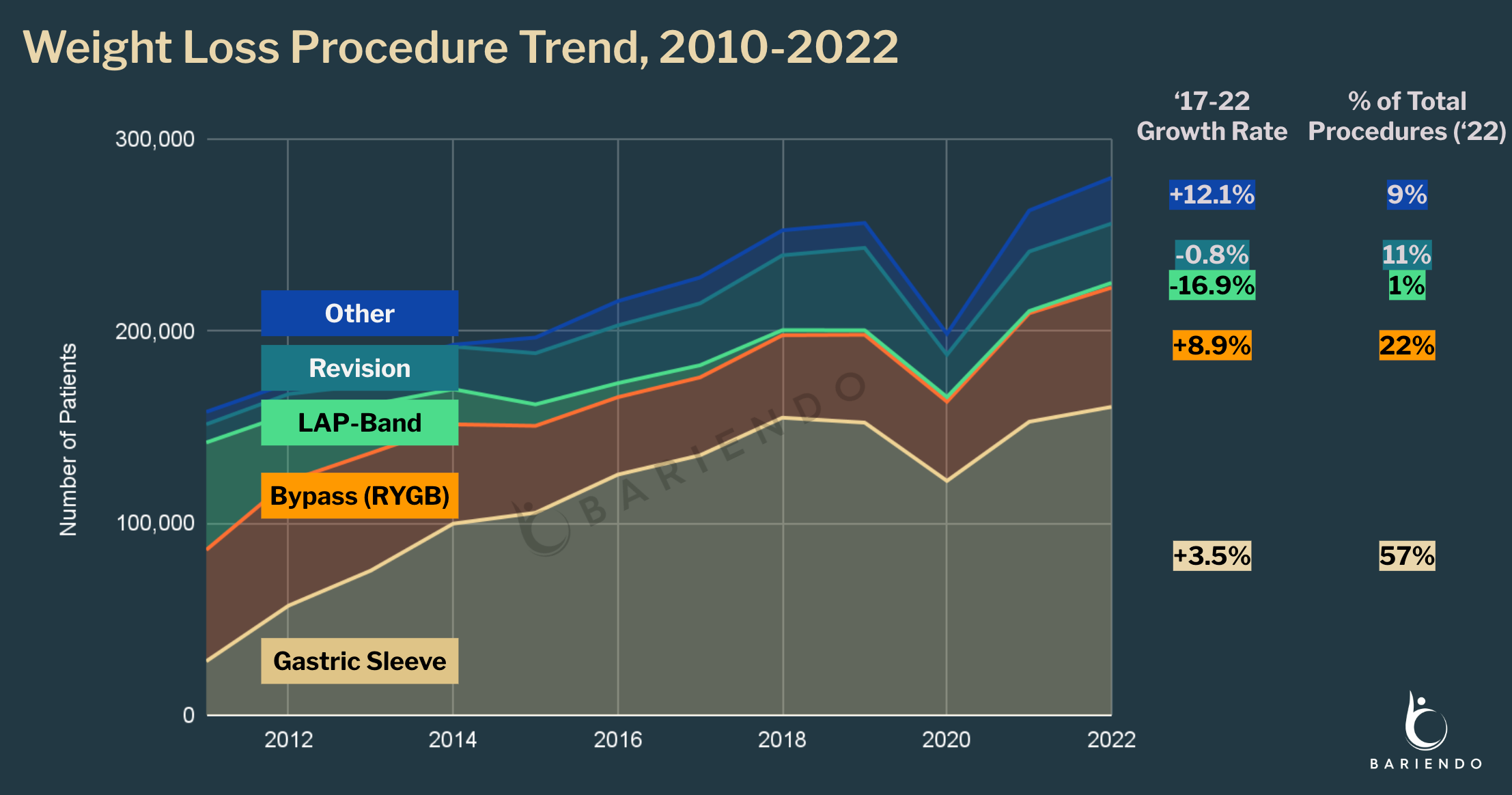Comparing ESG vs VSG? Explore 12 Factors That Matter Most
Considering ESG vs VSG for weight loss? Explore our in-depth comparison of ESG vs gastric sleeve and set yourself on the path to successful weight loss!

Bariendo Team
Team @ Bariendo
Is ESG better than gastric sleeve? If you’re considering weight loss procedures, you might be wondering how Endoscopic Sleeve Gastroplasty (ESG) stacks up against Vertical Sleeve Gastrectomy (VSG). While both procedures are highly effective solutions for significant and sustainable weight loss, they come with distinct differences that could impact your choice.
Below, we’ll break down the key differences between ESG and VSG and evaluate eleven factors to weigh into your decision-making process. By the end, you’ll have a clear picture of how ESG compares to sleeve gastrectomy and which option is the better fit for you.
Understanding the Difference Between ESG and Gastric Sleeve
The main difference between ESG and VSG is that ESG is not surgery. Both methods promote significant weight loss by reducing the size of the stomach, slowing gastric emptying, enhancing metabolism, and increasing satiety hormones, but they differ greatly in their approach.
What is ESG?
ESG Stomach Tightening is a groundbreaking weight loss procedure pioneered by our co-founder, Dr. Christopher C. Thompson. It’s performed endoscopically, and unlike traditional surgery, ESG doesn’t require any external incisions. Instead, it uses an endoscope - a thin, flexible tube with a camera and suturing device attached - to perform the procedure through the mouth.
ESG reduces the size of the stomach by 70%, so patients feel fuller sooner and stay satisfied longer, leading to reduced calorie intake and significant weight loss. Because it’s non-invasive, ESG is performed as an outpatient procedure and most patients can go home the same day.
What is VSG?
Vertical Sleeve Gastrectomy (VSG) is a surgical weight loss procedure designed to promote significant weight loss.. It involves the surgical removal of a large portion of the stomach through a few small incisions in the abdomen. The remaining stomach is shaped like a sleeve, which limits the amount of food it can hold.
The alteration to the stomach is permanent. A short hospital stay and a longer recovery period are required due to the invasive nature of the procedure. Patients usually need several weeks to fully recover and return to their daily routine.
Comparing ESG vs Gastric Sleeve Surgery
Choosing the right weight procedure is a pivotal decision that can transform your life. Effective obesity treatment not only leads to significant weight loss but also brings remarkable health benefits, including improved longevity and better quality of life.
Both procedures have been proven to be effective for substantial weight loss, so how can you decide which is right for you? Let’s explore 12 critical factors that set ESG and Vertical Sleeve Gastrectomy apart.
1. Invasiveness
Endoscopic Sleeve Gastroplasty (ESG), is a non-invasive procedure performed through the mouth using an endoscope, which eliminates the need for incisions. This is a significant advantage because there are no external scars, and most patients can go home the same day.
In contrast, Vertical Sleeve Gastrectomy (VSG), involves the surgical removal of a large portion of the stomach through small external incisions in the abdomen. This approach is more invasive, resulting in a longer hospital stay and increased recovery time.
2. Recovery Time
ESG allows for a faster recovery time due to its non-invasive nature. Most patients can return to work and their normal activities within a few days. And, since there are no incisions, post-procedure discomfort is present, but minimal. This quicker recovery also means patients can resume physical activity sooner to maximize their weight loss results.
On the other hand, VSG requires a longer recovery time due to its invasive nature. Patients usually spend a few days in the hospital, and it may be several weeks before they can resume their normal activities. Since there is an incision and permanent alteration of the stomach, post-operative pain and monitoring for potential complications can extend the downtime.
3. Hospital Stay
Another major pro of ESG is that it’s performed on an outpatient basis. Most patients don’t require an overnight stay in the hospital. They can return home the same day, which minimizes the disruption to daily life and reduces the overall cost of the procedure.
Since VSG is a surgical procedure that requires an incision, patients typically spend a few days in the hospital to recover from the surgery and ensure there are no immediate complications.
4. Procedure Duration
Due to the non-invasive, endoscopic nature of ESG, the procedure can be completed in about an hour. On the other hand, VSG is a more complex surgical procedure that takes around 1-2 hours to perform.
5. Weight Loss Outcomes
Clinical trials show that ESG is both an effective and safe procedure for promoting substantial weight loss. Patients who undergo ESG typically lose 18% of their body weight within the first year. They also experience a reduction or resolution of obesity-related comorbidities.
VSG offers slightly higher results, with patients losing around 23-25% of their body weight in a similar timeframe.
6. Potential Risks and Complications
ESG carries a 1% risk of complications compared to the 12-18% associated with gastric sleeve. The significantly lower risk associated with ESG is due to the procedure’s non-invasive nature. Some patients experience mild nausea and discomfort after the procedure, but they usually resolve quickly.
Post-surgery complications associated with VSG can include increased pain and discomfort, infections, bleeding, delayed wound healing, and leaks at the site where the stomach was stapled. Longer-term issues like nutritional deficiencies or gastrointestinal problems are also possible.
That being said, both procedures do require the use of general anesthesia. Although anesthesia is generally considered low risk for most patients, there are potential complications associated with its use, including allergic reactions and respiratory issues.
Our expert team will carefully assess your overall health and help you evaluate any potential risks to consider before moving forward with your procedure. For most patients, the risks of not addressing obesity head-on far outweigh any potential risks associated with general anesthesia.
7. Reversibility
Unlike traditional bariatric surgery, ESG is reversible. The sutures used during the procedure can be adjusted or removed, and there are no permanent changes to the digestive system. This offers greater flexibility for revising or reversing the procedure if you’re not seeing the results you expected or you encounter unexpected complications.
On the other hand, VSG involves permanent alteration to the stomach. While there is some room to revise the procedure endoscopically, complete reversal isn’t possible. This presents a significant barrier for patients who may be concerned about making permanent changes to their anatomy.
8. Cost
ESG Stomach Tightening costs around $12,000, making it a more affordable option compared to gastric sleeve. This lower price point is due to the simplicity of the procedure, which eliminates the need for a hospital stay and extensive post-operative care.
The cost of VSG usually falls between $17,000 and $26,000 or more, due to the complexity of the surgery, longer hospital stay, and more comprehensive post-operative care. There may also be additional expenses associated with the longer recovery period and delayed return to work.
The affordability of ESG is a significant advantage, but it’s important to note that the procedure is not typically covered by insurance. Although ESG was recently approved by the FDA, most insurance companies still consider it to be elective. That being said, FDA approval validates the procedure’s safety and effectiveness, so it will likely gain insurance coverage in the future.
In the meantime, Bariendo works with two premier financing patterns who offer financing options for procedures like ESG and non-invasive gastric balloon, which aren’t currently covered by medical insurance. This option makes these procedures more accessible by allowing patients to break up the costs into manageable monthly payments.
9. Eligibility
If you have a BMI of 30 or higher and have struggled to lose weight through healthy lifestyle changes, you may be eligible for ESG. The procedure may also be considered for those with a BMI of 27 - 29.9 who have certain obesity-related health conditions.
ESG is typically suitable for a wider range of patients than VSG, which is reserved for patients with a BMI of 35 or higher whose previous attempts to lose weight have been unsuccessful. The stringent requirements of VSG reflect its invasive nature, and it’s more suitable for those who need more substantial intervention for weight loss.
10. Lifestyle and Dietary Changes
Both ESG and VSG require healthy diet and lifestyle changes to achieve optimal weight loss results. Patients are encouraged to adopt a well-balanced, lower-calorie diet and engage in appropriate physical activity regularly to support weight loss and maintain results.
Due to their smaller stomach size, patients will need to follow a carefully structured eating plan to avoid discomfort and ensure proper nutrition. This includes eating smaller, more frequent meals and avoiding high-calorie or high-fat foods.
With both procedures, success largely depends on the commitment to these lifestyle and dietary adjustments. These guidelines are designed to enhance weight loss outcomes and improve overall health.
11. Exercise After ESG and VSG
One of the significant advantages of Endoscopic Sleeve Gastroplasty (ESG) is the ability to return to physical activity relatively quickly. Patients are encouraged to start exercising within a few days of the procedure, although it’s important to avoid exercises that strain the abdomen or are overly intense. This early return to activity helps maintain muscle mass and supports the establishment of healthy exercise habits, which are crucial for long-term weight loss success.
In contrast, Vertical Sleeve Gastrectomy (VSG) demands a more extended recovery period before patients can safely return to exercise. Typically, individuals need several weeks to heal fully before resuming any physical activity. This prolonged downtime can lead to muscle loss and make it more challenging to restart exercise routines, potentially hindering overall weight loss progress. Additionally, the longer recovery period associated with VSG, due to its invasive nature, means more time managing post-operative pain and monitoring for complications, further delaying the return to normal activities.
12. Follow-Up Care
Typical follow-up care after ESG involves a series of appointments with our healthcare team to monitor your progress and help you maximize your results. These visits often include dietary and nutrition recommendations, exercise guidelines, and advice on other strategies to maximize and maintain long-term weight loss.
Follow-up care after VSG is more intensive, with frequent appointments initially to monitor recovery, manage any complications, and adjust dietary recommendations as needed. VSG patients may also need additional support for preventing nutritional deficiencies that can arise after the surgery.
VSG vs ESG: Which is Right for Me?
ESG Stomach Tightening offers a promising alternative to Vertical Sleeve Gastrectomy for patients who are seeking a safe and effective solution for significant weight loss. While VSG is more invasive, requires a longer recovery period, and comes with a higher complication rate, it also delivers a higher weight loss rate. Evaluating the 12 factors above will help you make an informed decision and set you on the path to successful weight loss!
Take the first step toward a healthier you with a free consultation at Bariendo! Our team of top clinicians and weight loss experts can provide personalized guidance and support based on your overall health and weight loss goals.

